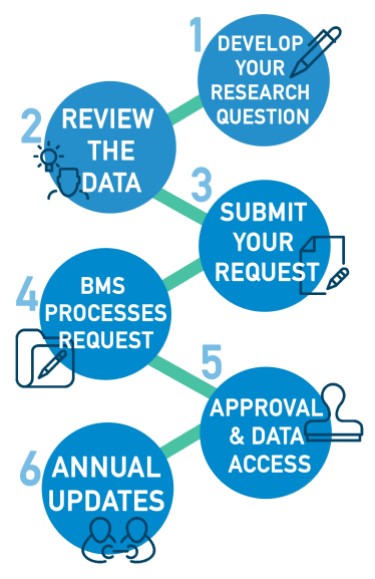

Image description: a flowchart with 6 steps: #1 Develop your research question, #2 Review the data, #3 Submit your request, #4 BMS Processes request, #5 Approval and data access, #6 annual updates.
What is the BMS National Database?
The Burn Injury Model System National Database is a prospective, longitudinal, multi-center research data repository that contains measures of functional and psychosocial outcomes following burns. The BMS National Database consists of data collected from individuals with moderate to severe burn injury to learn more about long-term outcomes after a burn injury. BMS data are collected either by paper and pencil, in person or over the phone interviews, or using online surveys. Surveys are completed at discharge from the hospital, 6-months post injury, 12-months post injury, 24-months post injury, and then every five years thereafter. Procedures for data collection are guided by the Standard Operating Procedures.
The DOI for the BMS NDB is: DOI 10.17605/OSF.IO/SWC2P
Who Can Use This Database?
The BMS National Database welcomes the use of the data by external researchers who share our goal of improving lives of burn survivors.
To review the data in the database, review the Annual Report (PDF)
BMS National Database Objectives
The objective of the BMS National Database is to provide a core set of variables which support rigorous research that:
- Contributes to improved care and outcomes of individuals (both adult and pediatric) with severe burns.
- Contributes to evidence-based rehabilitation interventions and clinical and practice guidelines that improve the lives of individuals with severe burns.
- Studies the longitudinal course of severe burn injuries and their secondary effects and factors that affect that course.
- Identifies and evaluates trends over time in etiology, demographics, injury severity characteristics, treatment of burns, health services delivery, and short-term and long-term outcomes of persons who incur a severe burn.
- Establishes expected rehabilitation outcomes for persons with severe burns.
- Facilitates other research such as the identification of potential persons for enrollment in appropriate burns clinical trials and research projects or as a springboard to population-based studies.
What is in the Database?
The BMS NDB contains data on over 4,000 adults and 2,000 children with moderate to severe burn injury (for a complete list of inclusion criteria, click here). The variables and measures collected include demographics (such as sex, age, race and ethnicity), injury characteristics (such as total body surface area burned and etiology of injury), and outcome measures that assess domains such as pain, itch, depression, and more. Some specific measures currently collected include PROMIS-29, and the Post Traumatic Growth Inventory.
See an overview of all variables collected
You may also visit our interactive BMS Data Dictionary Explorer!
What Are the Two Types of BMS Data Access?
Annually Published Public Access
The Public Dataset is published annually and contains data collected up to two years prior to its publication date. Data are stripped of all HIPAA-defined identifiers, including names, geographic subdivisions smaller than a state, elements of dates (except year) related to an individual, telephone numbers, fax numbers, email addresses, social security numbers, and medical record numbers.
Custom Data Access
A Custom Data Set includes all available data (i.e., all data available at the time of request), and is available free of charge to researchers with specific hypotheses who might want BMS input or collaboration.
What Is the Difference Between Annually Published and Custom Datasets?
The Annually Published Dataset includes:
- All BMS data available except identifiers
- Data collected up to 2 years prior to the publication date, i.e., data in the dataset is older than 2 years before the publication date
A Custom Dataset includes:
- Only variables you request and are necessary to answer your research question(s)
- Most recent data available at the time of request
Both datasets:
- Contain de-identified data
- Require users to agree to a data use agreement
Please continue to the How to Request BMS Datasets page if you’d like to work with BMS data.
